Legos in the Land of the Morning Calm
by Genny O’Herron
A small group of educators in Albuquerque, New Mexico came together around the shared passion of global and international children’s literature. Our group was diverse, consisting of classroom teachers, a university professor, a theater educator and a documentary film maker/substitute teacher. Calling ourselves the Adolescent and Children’s Literature Inquiry Project (ACLIP), we met monthly to discuss literature, individual projects, and classroom ideas. When we were awarded a Global Literacy Communities Grant, we decided to acquire global and multicultural literature about South Korea and Korean Americans and create a traveling collection of books that would benefit each ACLIP member in distinct ways. For example, one member used the books with her young theater students for script writing; one member shared the books with her Korean Mother’s Support Group; and one member shared the books with her Children’s Literature course at UNM. When it was my turn with the books, I used them with my third-grade students, and all of the ACLIP members supported me in this endeavor.
This vignette reflects some of what happened during that experience and demonstrates the capacity that young children have to explore issues of cultural authenticity and accuracy in books. This was my first year teaching third grade after teaching Kindergarten for six years, so not only was I learning about how to effectively integrate global and international children’s literature, I was also learning a lot about the spunk and spirit of eight and nine year olds! In the end, I also learned a lot about myself as a white middle class woman in the teaching profession who is trying to become more culturally competent and committed to a pedagogy of equity and diversity.
In all honesty, I was apprehensive about facilitating an in-depth cultural inquiry about a culture that I was not familiar with. I felt deeply insecure about my skills and how to do it “the right way.” That is where the collaboration and support from the other ACLIP members was essential, both to embolden me to stretch and grow as a teacher and to brainstorm about how to best present material so that I was not reinforcing stereotypes or misinformation. We began our study with what is frequently called the “five fs” (food, fashion, festivals, famous people, and folklore). This was very straightforward, and it is probably the only information I would have provided if had not been for the help of the ACLIP members to contact guest speakers, connect with pen pals from Seoul, and organize simple language lessons. With their support and guidance, the pieces started to come together—there was an organic unfolding of information, inquiries, and excitement on behalf of all of us (students, teacher and the ACLIP members). The students began reading an abundance of literary and informational texts. They watched a number of travel videos and You Tube clips of South Korea. They learned a lot! We learned a lot!
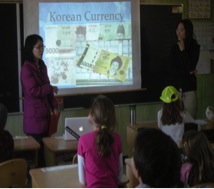 South Korean visitors expanded students’ knowledge about Korean culture
South Korean visitors expanded students’ knowledge about Korean culture
The single most important thing they learned was that children in this high-tech nation on the other side of the globe are similar to them as well as different. This may sound simplistic and cliché, but watching curious, creative youngsters become so knowledgeable—and concerned—about another group of people was profound for me.
According to the U.S. Census, 2.6% of the Albuquerque population identifies as Asian American (1.4% of the state population). On the first day that we dove into this project and looked at picture books and nonfiction texts about South Korea, most of the children had little or no background knowledge about this area of the world. I remember the lesson clearly. There were three distinct reactions: interest, indifference, and aversion. One child kept repeating, “This is freaky, this is so freaky,” as he paged through pictures of a people and place that were completely foreign to him. Another child insisted, “I don’t want to learn about this place. I hate Korea!” (he had just admitted that he knew nothing about South Korea). Yikes! What was I in for, I wondered: Is this what uncensored xenophobia, embodied in little third grade personalities, looks like? How does one teacher penetrate this type of resistance to intercultural understanding?
Through books, of course! (And collaboration with other educators committed to educational equity and diversity). Stories humanize. Information contextualizes. As Kathy Short (2013) wrote, “Through story, students understand the human emotions and struggles related to issues, and, through nonfiction, they explore the broader world context of those issues. Books are a powerful beginning point for expanding awareness and empathy.”
Expanding our Understandings through Using a Range of Literature
So, on the same day we began our unit about South Korea and Korean culture, I started our new lunchtime read aloud and made sure I tied the two together with the Newbery Medal winner A Single Shard by Linda Sue Park (2001). After the initial resistance from some, twelfth-century Korea came alive for us as we followed the story of Tree-Ear over the next few weeks. We also explored the career of Linda Sue Park by reading Linda Sue Park: An Author Kids Love (2009) by Michelle Parker-Rock after children began to devour her books.
I remember the enthusiasm about Linda Sue Park’s writing so well (it caught me by surprise; teaching third grade for the first time, I didn’t know which authors and literary works had strong appeal). “I like the book you gave me,” shared Seth who had just finished The Kite Fighters (2010), a book I lent him from our Park pile. “Can I get Archer’s Quest (2008) as soon as it comes back?” he begged, frustrated with his friend for forgetting it at home—the unbridled reading passion was palpable. This was the first time kids were practically fighting over the books they wanted to read in our classroom. They couldn’t get enough of Linda Sue Park during their independent reading time, and this dovetailed perfectly with our Korean inquiry.
Providing a wide range of books was critical to engaging the students, and in our case, we had to activate imagination first through fiction in order to stimulate intellectual curiosity. For example, while students were intently enjoying the Linda Sue Park books, there was not much interest in the nonfiction books that were available to them. As soon as we began to plan for our culminating project, our “Korean Class Museum,” however, there was strong motivation to consult as many resources as possible. Suddenly students were hoarding these books in their desks. The Museum was open to the entire school during our Winter Festival, and along with book displays, featured student-created dioramas, reports, and experiential activities like coin rubbing, crafts, taste testing and traditional games like Yut. By that point, students had clearly become authorities on many aspects of South Korea and were so proud to share that knowledge publically.
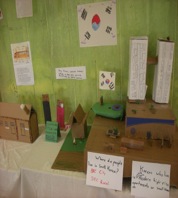 Students shared their learning in displays for a class Korean museum.
Students shared their learning in displays for a class Korean museum.
In addition to sharing literary and informational texts with students, I also introduced bilingual Korean-English books and books written in Korean that had English counterparts such as Minji’s Salon by Eun-hee Choung (2008), My Cat Copies Me by Yoon D. Kwon (2007), Something for School by Hyung Young Lee (2008), and The Zoo by Suzy Lee (2007). The third graders loved “reading” the Korean books first and then seeing the English translations. Finally, I pulled out the contemporary children’s picture books purchased in South Korea, written in Korean with vivid, captivating illustrations.
“I wish I could have these books in my house,” sighed Amy who was infatuated with the unique illustrations of the books. “It’s no fair that we can’t get these books here!” exclaimed Todd as he poured over the collection that the kids had termed the “Naughty Boy” series. While they couldn’t read the text, students carefully studied the illustrations and constructed a storyline for each book. The children who initially were most adamant about Korea being “freaky” and “hating” it came up with the most elaborate storylines.
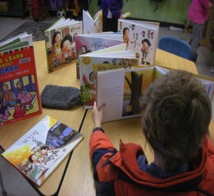
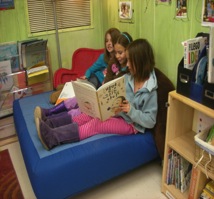
Children enjoy a wide range of books published in South Korea (written in Korean)
Challenging Misconceptions and Making Connections
As children synthesized information from the nonfiction and guest visitors, they noticed the preponderance of traditional imagery in picture books about Korea. “Why are most of the characters wearing hanbok (traditional clothing) in these books?” they asked, making astute observations about over-representations in books. When we re-read The Trip Back Home by Janet Wong (2000), for example, they commented about the rural imagery, noting what they had learned about the urbanization of South Korea (with less than about 20% of the population now living in rural areas). They also compared U.S.-published picture books to Korean ones, which had significantly more urban and contemporary images, including children playing with Legos, which riveted them. They started using words like traditional and modern very deliberately.
Contemporary images in books from South Korea expanded student connections and understandings.
Children also talked about similarities and differences between their lives and the lives of South Korean children (fictional and real) with much more sophistication. Childhood interests were common points of inquiry. They wanted to know if Korean children had pets and looked for evidence in books. They looked for the kinds of toys that were popular in South Korea and were both tickled and surprised to find illustrations of children playing Legos in the contemporary Korean picture books.
Another question that arose was whether Koreans like sushi. At first the sushi comments harkened me back to the time before we started this unit when my students had extremely limited and inaccurate knowledge about so many aspects of Asia, in general, and about South Korea, in particular. I was perplexed as to why these comments kept coming up, especially after they learned about the difference between sushi and the Korean rice rolls called kimbap. Then I heard stories from several students who held high social peer status and who had elaborate and entertaining stories about “loving sushi with their families,” “having sushi for their birthdays,” and “going out to a sushi restaurant with Grandpa.” The more I listened, the more it seemed that the question, “Do Koreans eat sushi?” wasn’t an ignorant confusion between Japanese and Korean culture but a natural curiosity and point of comparison and of asking, “What do Korean children and I have in common?” They seemed to be seeking understandings about whether Korean children value and enjoy the same things they did. If it’s “cool” to eat sushi, here, (according to many of the dominant personalities in the classroom), then what’s “cool” in South Korea?
Students graphed the amount of traditional and rural images they noted in fiction and nonfiction books about South Korea from the public library. It became clear that if these books were the only exposure that children had to the county and culture of South Korea, many stereotypes and misperceptions would be reinforced. The broader collection of global and international books, along with guest speakers and activities like playing yut and watching videos about Korean celebrities such as Yu-Na Kim (2010 Olympic champion figure skater) and Rain (entertainer, pop star), gave a more varied, vibrant, and nuanced depiction of South Korea.
By the end of our unit when the third graders wrote to fifth-grade pen pals from Seoul Gangdong Elementary School the orientalism, exotisim and “othering” had disappeared. Students shared intimate details about divorces, exciting news about upcoming vacations, and kid-centic reports about best friends, favorite foods and beloved cartoons and video games. They took great care in personalizing and polishing their letters. They asked questions about siblings, sports, gender (they really wanted to know if they were writing to a boy or girl!), entertainment, and school. They labored over their Korean alphabet charts in order to leave little notes in the margin written in Korean. Brian wrote a P.S., “We read a book that showed Korean children playing with Legos. Do you have the Star Wars X-Wing Starfighter? I just got that one for my birthday.”
Final Reflections
The language of childhood is a universal language, despite distinct cultural differences. Our inquiry into South Korea and Korean culture illuminated many interesting facts and findings and many similarities and differences. When similarities were highlighted there was instant intrigue and enthusiasm (do you know they have Dunkin Donuts in South Korea!?—this meant the world to a child whose Dad works for this company). The similarities abound beyond Legos and donuts, of course, and as students began to understand this more deeply, their curiosity became connection, These understandings of similar and difference are both needed in a world marked more and more by diversity and complex interdependencies.
I know students learned a lot from this study, but I would have to say I learned more. Not just about South Korea, but about how to bring global cultures alive in a meaningful, thoughtful way through literature and careful examination about what that literature portrays (and/or doesn’t portray) about a people. I am grateful for such an amazing learning opportunity, which was made possible through this project and the support of my ACLIP colleagues!
References
Choung , E.(2008). Minji’s salon. La Jolla, CA: Kane/Miller.
Kwon, Y. (2007). My cat copies me. La Jolla, CA: Kane/Miller.
Lee, H. Y. (2008). Something for school. La Jolla, CA: Kane/Miller.
Lee, S. (2007) The zoo. La Jolla, CA: Kane/Miller.
Park, L. S. (2006). Archer’s quest. New York: Clarion.
Park, L. S. (2001). A single shard. New York: Clarion.
Park, L. S. (2000). The kite fighters. New York: Clarion.
Parker-Rock, M. (2009). Linda Sue Park: An author kids love. Berkeley Heights, NJ: Enslow.
Short, K. The Common Core State Standards: Misconceptions about informational and literary text. WOW Currents blog, 1/21/2013
Wong, J. (2000). The trip back home. San Diego: Harcourt.
Genny O’Herron has been teaching at Mountain Mahogany Community School in Albuquerque, NM for eight years. She found her way to the Adolescent and Children’s Literature Inquiry Project through her graduate studies in the Language, Literacy and Sociocultural Studies department at University of New Mexico.
WOW Stories, Volume IV, Issue 8 by Worlds of Words is licensed under a Creative Commons Attribution-NonCommercial-ShareAlike 4.0 International License.
Based on a work at wowlit.org/on-line-publications/stories/iv8.

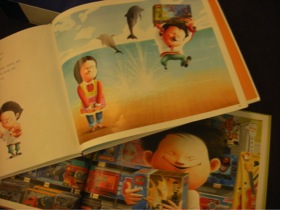
The journey with Genny and her students has been one of the most powerful experience I ever had with books about Korea. Childhood connections became a powerful tool for children to wake up their curiosity to Korean culture and kids in Korea. Eventually this whole experience let them to think about critical stance of reading. Even though language was not all in English, childhood connection helped them to jump over the huddle in language barrier yet helped them to study carefully other visual cues like illustrations in the Korean picture books in return. This particular story Genny O’Herron wrote is empowering for me as a member of ACLIP indeed.
I can honestly say that I truly enjoyed reading this article. When I search for information on reading within the classroom, the majority of the articles are based around the elementary and middle school aged students. I really appreciate this in-depth discussion of how the teacher helped her students make connections and allowed them to follow the path that the book took them on. I teach at the ninth grade level in all co-teaching classes. My students are mostly not very inquisitive. I believe they have been taught all along to simply read and do the questions. We have lost a lot of the fun in teaching reading and learning about the information in the book. I a very inspired by this classroom and the functionality of the processing of the actual information within the text. We need to teach our students how make those connection and inquire into why things are the way they are. I have always loved to read and have never understand the disdain that many students have for reading. However, I know that if I can get them even slightly interested in the subject matter at hand, then the process is so much smoother. Once again, this was a fantastic article that I will be passing along to my colleagues.
Thanks, I agree that there are few examples of using global literature in secondary school classrooms and there is so much potential at that age level. May kids, however, have learned not to think in schools because not much has been asked of them beyond basic literal level thinking. So while they are capable of so much thinking, they also have a long instructional history of not thinking which we have to get beyond. The potential is there, though, as you point out.